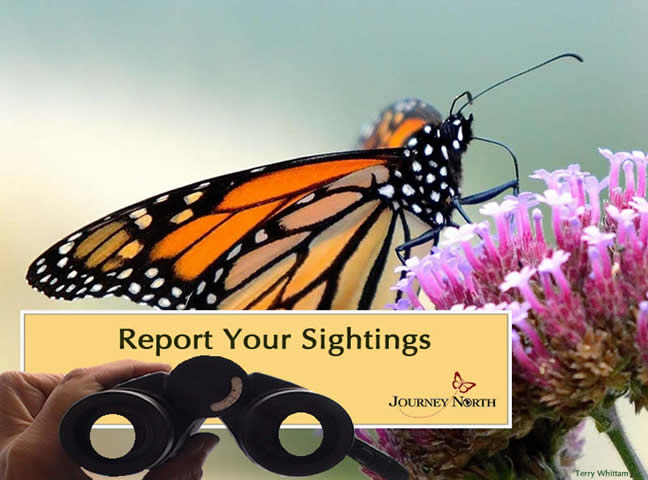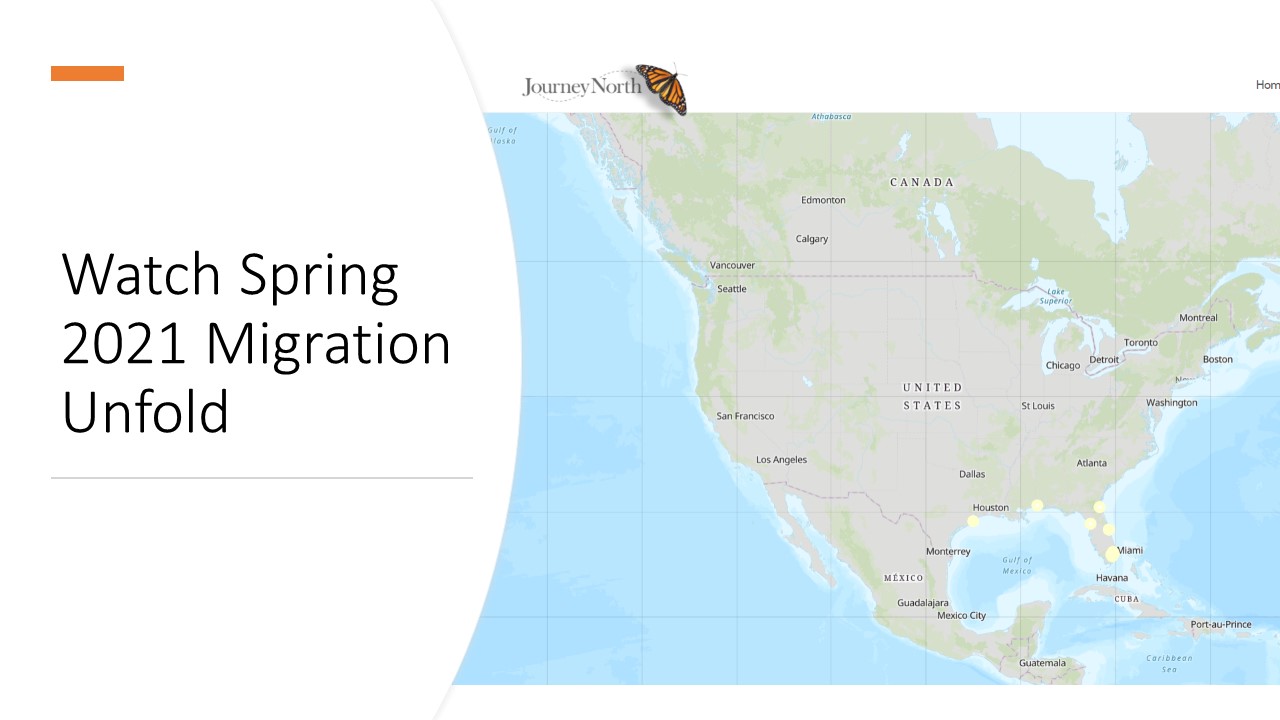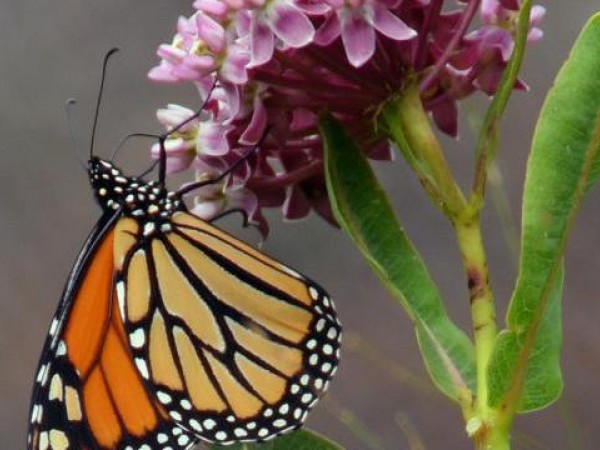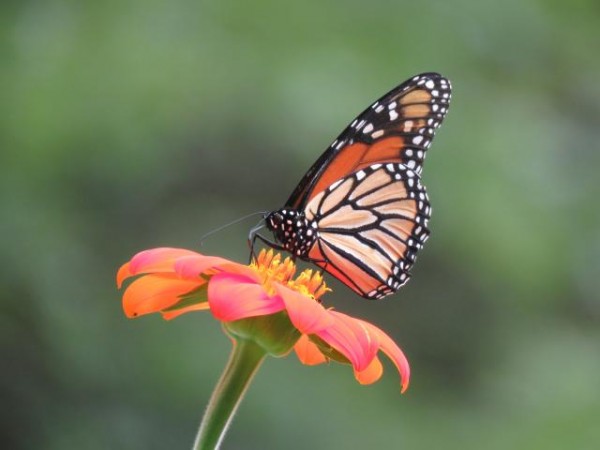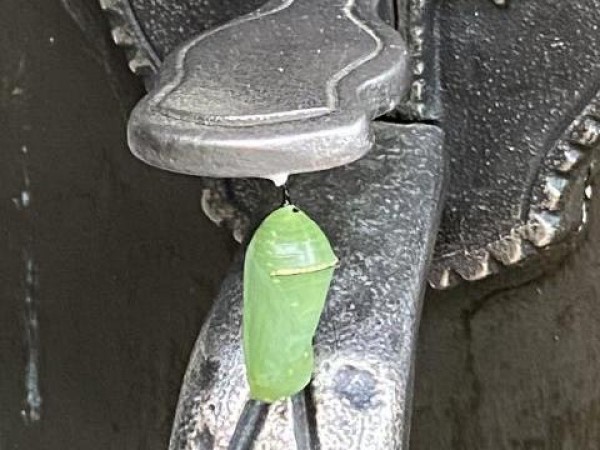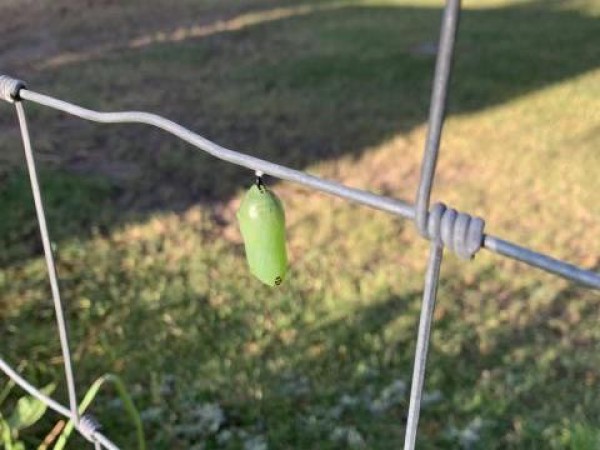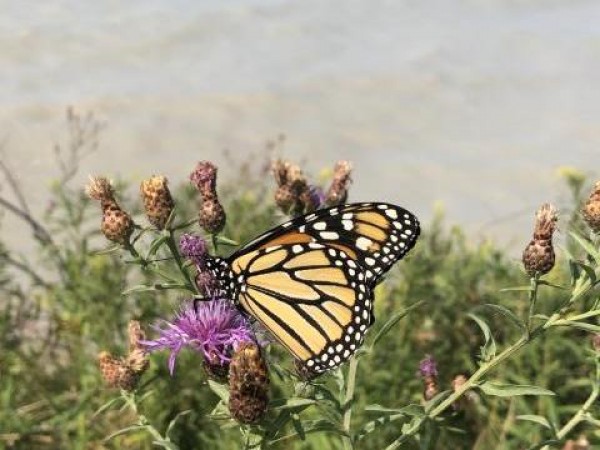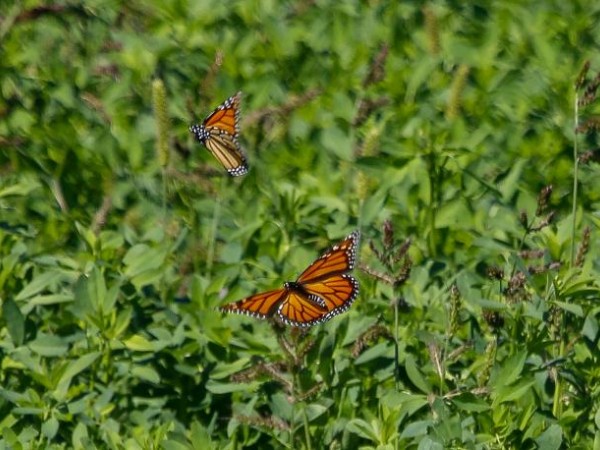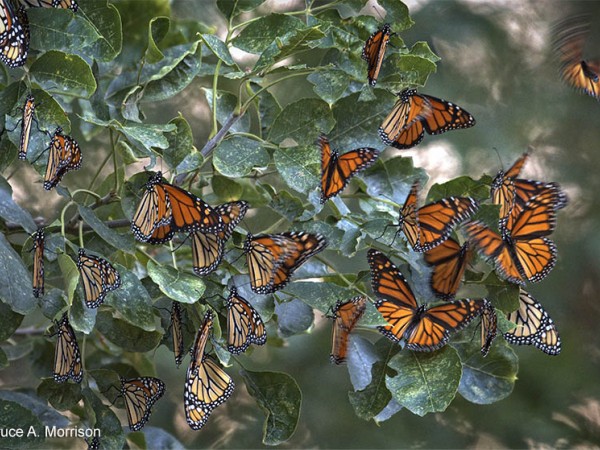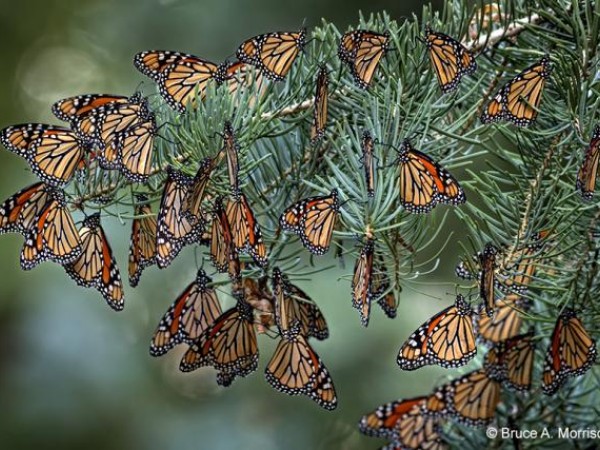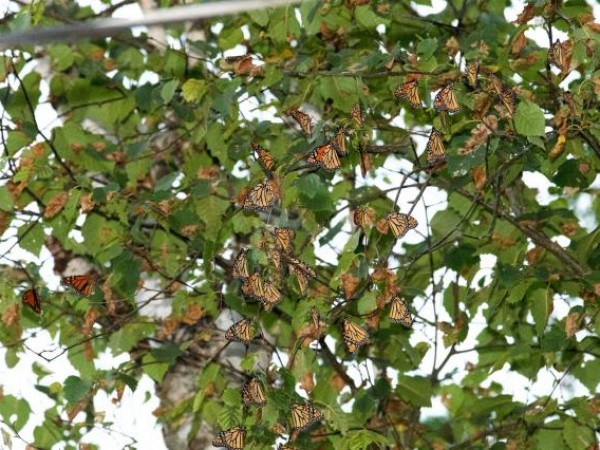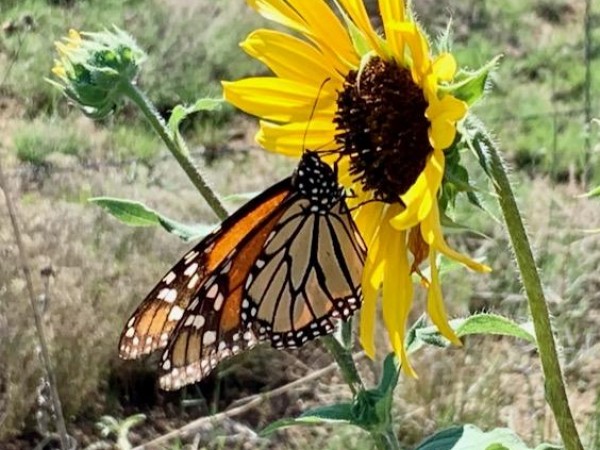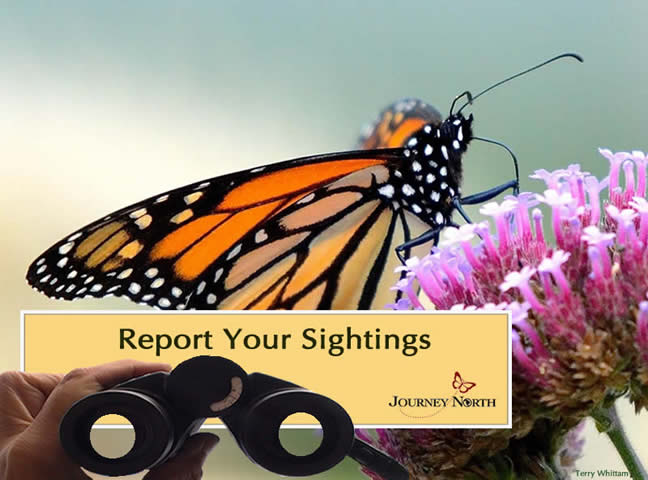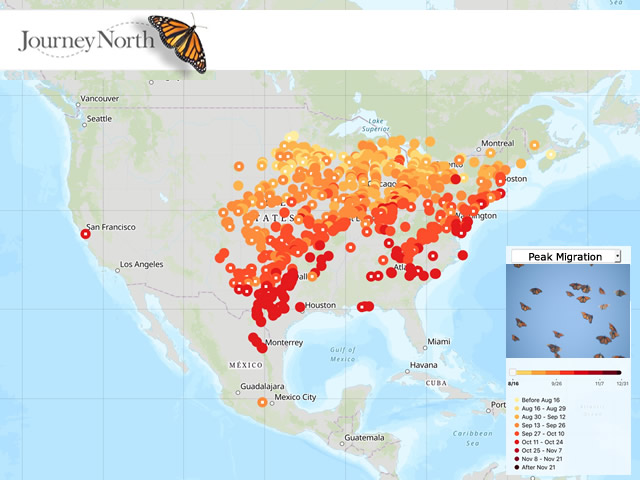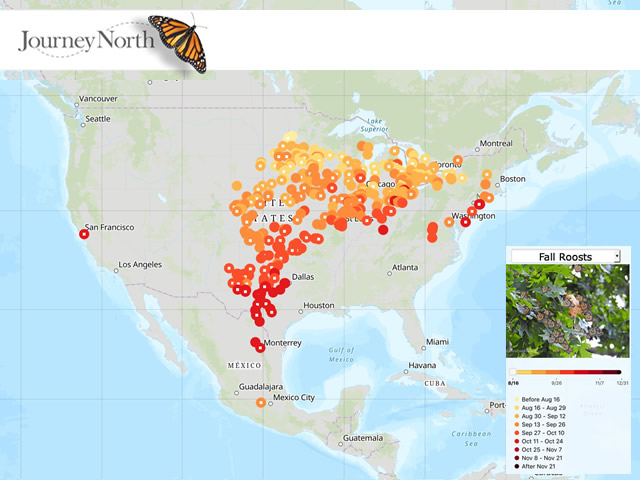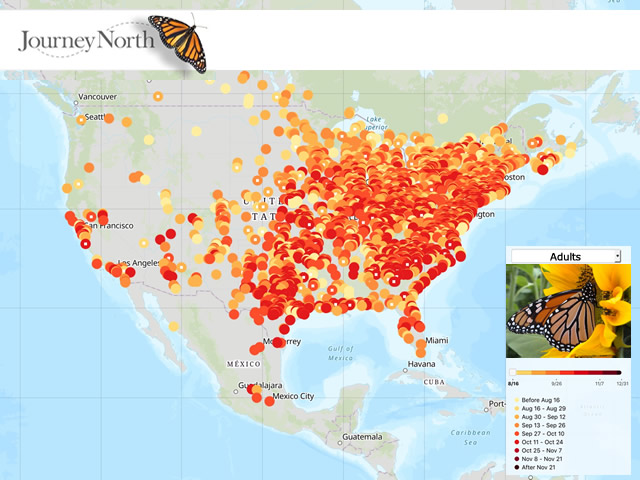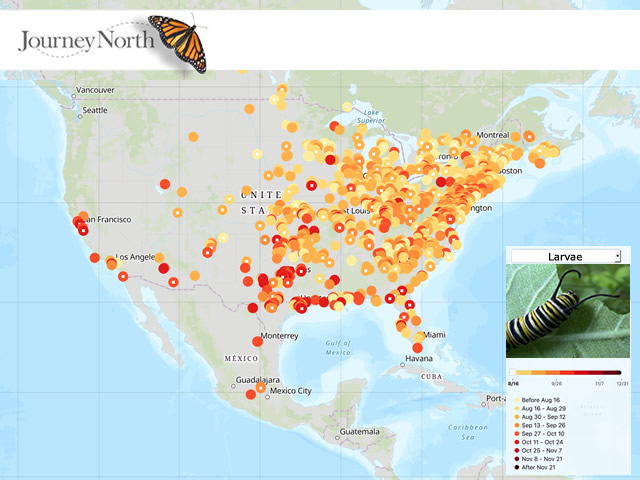On The Move
Eastern Monarch Population
Fueling Up, Heading South
Monarchs are on the move — flying, nectaring, and roosting. The migration is continuing to pick up steam. Monarchs are busy building their fat reserves by drinking nectar along their migration pathways. These migration pathways occur in large urban centers such Toronto, Detroit, Chicago, Kansas City, and Atlanta as well as the mountains of Maryland, Virginia, and West Virginia, the fields and prairies of southern Minnesota, Iowa, Kansas, and Nebraska, and along the coastlines of the Great Lakes, the Atlantic, and Gulf of Mexico. Migration excitement is building.
From Syracuse, NY: Janet "Nectaring at a Sullivant's milkweed in my back yard." (09/01/2020)
From Piedmont, SC: Candice observed, "Happy to see another Monarch passing thru." (08/25/2020)
Caterpillars and Chrysalises
Journey North citizen scientists are still submitting reports of caterpillars and chrysalises with some sightings from very unusual spots.
From Bement, IL: Thomas noted, "Larvae feeding is still in full-force. Numbers are slightly lower as I think many of the older instars are heading off to form their chrysalises, but there are still a good number of young ones appearing on the milkweed. Found these two this afternoon munching on the same common milkweed leaf. Haven't witnessed any egg-laying in the past couple of days." (09/01/2020)
Peak Migration
Many Journey North citizen scientists have reported monarchs traveling in a southerly direction. This is called directional flying. Others are actively measuring peaks in migrating monarchs.
From Goderich, ON: Blanca reported, "119 monarchs were counted flying in and out from trees and nectaring in an open field. The count was 20 minutes' walk on the loop trail of the Park. In the afternoon more monarchs were nectaring on Canada Thistle on the slope of the hill. Off Leash Dog Park, Goderich, Ontario. T 24 0C. Wind south direction. Speed 5 km/h. That was after an early foggy morning turned in a beautiful sunny day after 10:00 am." (09/01/2020)
From Dundee, QC: Wido observed, "My wife [and I] were out "Birding" in the region of Dundee, Quebec, Canada while waiting about an hours for Sandhill Cranes to show up...at least 50 Monarch Butterflies flying over the road in front, on the rear and over our car. It was an amazing sight. My wife pointing "look there is another one and another one sometimes in pairs of two"..." (08/31/2020)
Roosts Observed
About eighteen new monarch roosts were observed by Journey North citizen scientists since September 1st. Check out the Monarch Fall Roost map to see the location of these roosts. Roosts are difficult to study. We still have much to learn about and from monarch roosts. That's why it is so important to submit your monarch roost reports to Journey North. Roosts show us where large concentrations of migrating monarchs are found. Where roosts are located also reveal the main migration pathways to Mexico and the pace of the migration.
Bruce submitted several observations creating a detailed record of the formation and duration of a fall roost in Hartley, IA.
- On 08/29/2020: Bruce, "Found 23 Monarchs in the back yard of the acreage at 6pm this evening...hoping to check in the morning and see what I can find!"
- On 08/31/2020: Bruce submitted these comments, "Big movement tonight - have dozens of roosts here in the acreage with some small and some large to very large...quit counting at 650 as there were too many still coming in! The air is just full of them...now too dark to see. Will try early in the morning and see what we find. This roost formed yesterday evening (August 31, 2020) around 7:30pm. My wife and I both counted "clumps" and the numbers in the clumps - and then the "many" strung out small groups of individuals. I arrived at 650 as a fair estimate, my wife said she counted more, but I would rather error on the low side to be safe. I then recounted this a.m. before 7 o'clock and really came up with the same estimate.
- On 9/1/20: Bruce submitted this report, "The Monarch Roost here is decreasing - down to 400 this morning. They moved within the trees more as the breeze had shifted out of the SW, so about half the roost selected the spruces for shelter and the other half still elected to congregate on the lower Ash branches."
- On 09/02/2020: Bruce wrote, "We are down to just 5 in the acreage trees. The 400 we had [yesterday] are now gone. We have a cold front and high winds coming through so they are being helped south by the NW winds."
If you want to take a deeper dive into monarch roosts, check out Journey North archived materials:
- Do Monarchs Rest at the Same Roost Sites Every Fall?
- Field Studies You Can Do at Roost Sites
- Estimating the Number of Monarchs in a Roost: Let's Practice
- What do the locations of overnight roosts reveal about fall migration?
Western Monarch Population
The first 2020 Fall Report is in from Gail Morris!
Getting Ready!
Monarchs appeared in the summer breeding grounds across the West but their numbers varied by location. Early reports of tagged monarchs moving south and west from Oregon and Utah are already appearing as the annual Fall migration begins.
Western Monarchs
Monarch numbers in the Northwest reaches of the summer breeding area are bleak. Dr. David James at Washington State University said only two monarchs had been confirmed in the state of Washington by the end of August. “Despite claims of other monarchs sighted in WA, there has been no photographic evidence for these. We confirmed 8 monarch sightings in WA in 2019, which was the worst year for sightings for at least 20 years. Unless we get evidence of another 6 monarchs, this year will go down as the worst for monarchs in WA in two decades. Something else to remember 2020 for...”
Sightings varied across the region. Utah had an unusually good year for monarchs with their early arrival and breeding throughout the season. Right next door in Nevada, Citizen Scientists reported some of the lowest numbers in years. Arizona had monarchs present in all the breeding areas in the higher elevations but in lower numbers than usual. California coastal areas reported good numbers of monarchs. We’re all waiting to see what the Fall migration will bring. Be sure to report any monarch activity you see.
What You Can Do
Plant late booming flowers. The places monarchs feed and rest during migration are called stopover sites. Help monarchs by planting flowers that bloom late into the fall such as the Mexican Sunflower, Tithonia rotundifolia.
Keep reporting to Journey North. When submitting monarch roost data to Journey North, please include the following information in your comments:
- Date the roost first formed
- Nectar sources nearby like clover, alfalfa fields or wildflowers
- Overnight temperatures
- Wind direction. Were the monarchs shielded from the wind in this location?
- Tree species monarchs were roosting on
- PhotosHow you counted or estimated the number of adults roosting
Fall Monarch Migration 2020
Please report all monarchs you see: Adults, Eggs & Larvae, Overnight Roosts, Peak Migration Events


